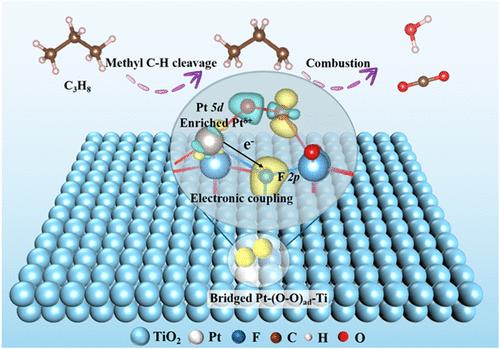利用活性氧构建电子富集 Ptδ+ 以增强丙烷催化燃烧
IF 8.2
2区 材料科学
Q1 MATERIALS SCIENCE, MULTIDISCIPLINARY
引用次数: 0
摘要
由于 O2 和 C3H8 分子的氧化作用之间存在竞争吸附,因此在低温下完全催化氧化丙烷(C3H8)仍然具有挑战性。在本研究中,我们提出了一种增强 C3H8 氧化的创新方法,即在掺杂 F 的 TiO2-supported Pt 催化剂(Pt/F-TiO2)上战略性地设计具有调制电子结构的活性 Ptδ+ 位点。我们的机理研究发现,Pt 5d 和 F 2p 之间的电子耦合改变了 d 轨道电子特性,从而产生了大量高效电子富集的 Ptδ+ 物种。这些新的 Ptδ+ 位点有利于 C3H8 的吸附,并促进化学吸附的 O2 以 Pt-(O-O)ad-Ti 桥的形式活化成超氧化物,从而协同促进 C3H8 中甲基 C-H 的裂解。本研究提出了铂基催化剂活性位点电子结构工程的策略,为开发用于丙烷氧化的高性能催化剂铺平了道路。本文章由计算机程序翻译,如有差异,请以英文原文为准。

Construction of Electron-Enriched Ptδ+ with Reactive Oxygen Species for Enhanced Propane Catalytic Combustion
The complete catalytic oxidation of propane (C3H8) at low temperatures remains challenging due to the competitive adsorption between the oxidation of the O2 and C3H8 molecules. In this study, we propose an innovative approach to enhance C3H8 oxidation by strategically designing active Ptδ+ sites with modulated electronic structures on F-doped TiO2-supported Pt catalyst (Pt/F-TiO2), which exhibits 50 and 90% of propane conversion at 200 and 320 °C. Our mechanistic study reveals that the electron coupling between Pt 5d and F 2p alters the d orbital electron property, which leads to generation of abundant efficient electron-enriched Ptδ+ species. These new Ptδ+ sites facilitate the adsorption of C3H8 and promote the activation of chemisorbed O2 into superoxide species, in the form of bridge Pt-(O–O)ad-Ti, which synergistically facilitates the methyl C–H cleavage in C3H8. This study presents the strategy for electronic structure engineering of active sites in Pt-based catalysts, paving the way for the development of high-performance catalysts for propane oxidation.
求助全文
通过发布文献求助,成功后即可免费获取论文全文。
去求助
来源期刊

ACS Applied Materials & Interfaces
工程技术-材料科学:综合
CiteScore
16.00
自引率
6.30%
发文量
4978
审稿时长
1.8 months
期刊介绍:
ACS Applied Materials & Interfaces is a leading interdisciplinary journal that brings together chemists, engineers, physicists, and biologists to explore the development and utilization of newly-discovered materials and interfacial processes for specific applications. Our journal has experienced remarkable growth since its establishment in 2009, both in terms of the number of articles published and the impact of the research showcased. We are proud to foster a truly global community, with the majority of published articles originating from outside the United States, reflecting the rapid growth of applied research worldwide.
 求助内容:
求助内容: 应助结果提醒方式:
应助结果提醒方式:


